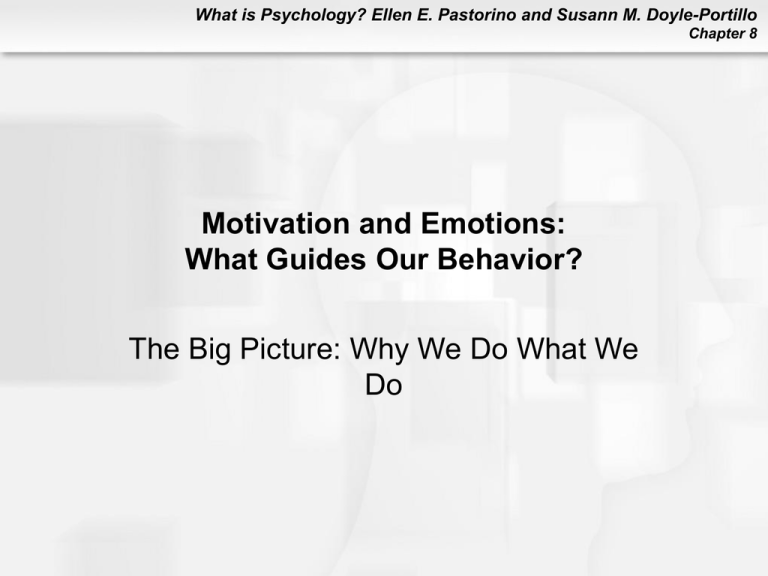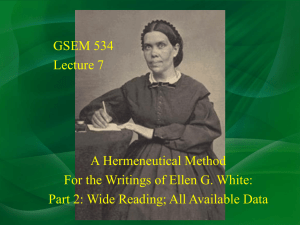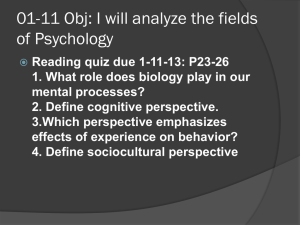What Guides Our Behavior? - Valdosta State University
advertisement

What is Psychology? Ellen E. Pastorino and Susann M. Doyle-Portillo Chapter 8 Motivation and Emotions: What Guides Our Behavior? The Big Picture: Why We Do What We Do What is Psychology? Ellen E. Pastorino and Susann M. Doyle-Portillo Chapter 8 The Big Picture: Why We Do What We Do • Motive – tendency to desire, seek out positive incentives/rewards and to avoid negative outcomes • Motives serve to protect us – eat, drinks, engage in some detrimental behavior • When motives go astray – The story of Marya, a child with bulimia and anorexia What is Psychology? Ellen E. Pastorino and Susann M. Doyle-Portillo Chapter 8 Theories About Motivation • Various ways motive has been explained – Instincts: inborn forces that direct behavior – Drives: uncomfortable biological states seek to change – Arousal: desire to maintain optimal level – Incentives: seek rewards from world • No one view complete in itself What is Psychology? Ellen E. Pastorino and Susann M. Doyle-Portillo Chapter 8 Motivation as an Instinct • Influenced by Charles Darwin/theory of natural selection • William James, American psychologist, proposed that instincts motivate behavior • Form habits that fulfill daily needs What is Psychology? Ellen E. Pastorino and Susann M. Doyle-Portillo Chapter 8 Motivation as a Drive • Drive-reduction theories: motivation comes from desire to reduce internal, uncomfortable, state (drive) when needs not fulfilled • Primary drives maintain homeostasis/equilibrium such as food, water – Negative feedback loop: information systems monitor bodily process, adjust accordingly • Secondary drives motivate behaviors not related to biological needs What is Psychology? Ellen E. Pastorino and Susann M. Doyle-Portillo Chapter 8 What is Psychology? Ellen E. Pastorino and Susann M. Doyle-Portillo Chapter 8 Does Drive Reduction Theory Really Explain Our Behavior? • Does it sufficiently explain things like achievement or desire for love • Does it explain things such as overeating? Eating disorders? • At times motivated to increase (not decrease) arousal in bodies (riding a roller coaster); not explained by drive reduction What is Psychology? Ellen E. Pastorino and Susann M. Doyle-Portillo Chapter 8 Arousal Theories of Motivation • Operate best at optimal level of arousal (often moderately aroused); too much or too little arousal weakens performance • Sensation seekers – Seek out levels of arousal higher than most – Zuckerman found low levels of monoamine oxidase (MAO) in sensation seekers – MAO affects dopamine release; may cause sensation seekers to seek intense arousal What is Psychology? Ellen E. Pastorino and Susann M. Doyle-Portillo Chapter 8 What is Psychology? Ellen E. Pastorino and Susann M. Doyle-Portillo Chapter 8 Incentive Theories of Motivation • Incentives are things that motivate to action • Extrinsic motivation is behavior that is motivated from outside (praise, material items) • Intrinsic motivation are incentives that come from within (feeling good about self, pride in accomplishment) What is Psychology? Ellen E. Pastorino and Susann M. Doyle-Portillo Chapter 8 Intrinsic versus Extrinsic Motivation – Which One Is Best? • Advantages of intrinsic motivation – No extrinsic incentives needed – Extrinsic motivators/tangible reinforcers lower motivation to engage in task • justification effect – Intangible reinforcers motivate without extrinsic incentives • Advantages of extrinsic motivation – Can help motivate when not intrinsically motivated What is Psychology? Ellen E. Pastorino and Susann M. Doyle-Portillo Chapter 8 Maslow’s Hierarchy of Needs • Hierarchy of needs – Basic human needs: physiological, safety and security – Psychological needs: belongingness and love, esteem – Self-fulfillment needs: self-actualization and transcendence – Lower needs need to be met first before can meet higher need – Hierarchy not supported by research but still used in business, marketing, etc. What is Psychology? Ellen E. Pastorino and Susann M. Doyle-Portillo Chapter 8 Hunger and Thirst: What Makes Us Eat and Drink • Eating is most fundamental motivation, ensures survival • Motivation to eat remains strong even when we fight it (e.g. eating disorders) What is Psychology? Ellen E. Pastorino and Susann M. Doyle-Portillo Chapter 8 Hunger and Feedback in the Body • Hunger motivates us to eat when needed • Brain turns hunger off and on in order to maintain homeostasis (negative feedback loop) What is Psychology? Ellen E. Pastorino and Susann M. Doyle-Portillo Chapter 8 Hunger and Feedback in the Body Feedback from the Stomach • Stomach is one part of body that signals hunger (the balloon experiment) • Stomach also plays role in telling brains to stop eating • Receptors in wall of stomach measure nutritive value of food eaten; both quality and quantity • Rate at which food leaves stomach related to caloric content of food What is Psychology? Ellen E. Pastorino and Susann M. Doyle-Portillo Chapter 8 Hunger Feedback from the Liver • Liver monitors glucose and glycogen levels • Glucose – sugar needs for energy; glycogen starch that is stored • Too much glucose, turns off hunger; if dip into energy reserves, turns on hunger What is Psychology? Ellen E. Pastorino and Susann M. Doyle-Portillo Chapter 8 Hunger Feedback from Hormones • Insulin, made in pancreas, increases hunger • Cholecystokinin (CCK) released from small intestines, shuts off eating What is Psychology? Ellen E. Pastorino and Susann M. Doyle-Portillo Chapter 8 Hunger Feedback from Fat Cells • Fat cells store fuel reserves that are mobilized when bodies need fuel • Also make and secrete chemical called leptin; informs brain about level of available fat reserves • If brain senses high leptin levels, hunger is reduced What is Psychology? Ellen E. Pastorino and Susann M. Doyle-Portillo Chapter 8 Hunger Regulation in the Brain • Processes signals from stomach, liver and leptin • Glucoreceptors in hypothalamus measure glucose levels in bloodstream What is Psychology? Ellen E. Pastorino and Susann M. Doyle-Portillo Chapter 8 Hunger Regulation in the Brain (continued) • Evidence supporting findings: – Lateral hypothalamus (LH) functions as “on switch”; destruction of LH creates starvation – Neuropeptide Y, appetite stimulant, affects part of brain outside of LH – Hypothalamus shuts off hunger; destruction of ventromedical hypothalamus (VMH) creates obesity; new set point reached What is Psychology? Ellen E. Pastorino and Susann M. Doyle-Portillo Chapter 8 External Cues that Influence Eating: Culture and Consumerism • Sight or smell of food sparks hunger • Relate food to customs, holidays, celebration • Connect joy and food What is Psychology? Ellen E. Pastorino and Susann M. Doyle-Portillo Chapter 8 What Causes Obesity: Nature and Nurture, Again • Two-thirds of Americans are considered overweight; one-third of those obese • Body mass index (BMI) one way of measuring obesity • Obesity causes multitude of health issues What is Psychology? Ellen E. Pastorino and Susann M. Doyle-Portillo Chapter 8 Factors Controlling Eating What is Psychology? Ellen E. Pastorino and Susann M. Doyle-Portillo Chapter 8 What is Psychology? Ellen E. Pastorino and Susann M. Doyle-Portillo Chapter 8 Behavioral Factors in Obesity • Poor diet – High fat diets – Emotional eating – More we diet, the harder it may be to lose weight; body fights against weight loss – May lead to bingeing – Emotional distress causes dieting slips • Lack of exercise – Exercise burn calories, more permanent weight loss What is Psychology? Ellen E. Pastorino and Susann M. Doyle-Portillo Chapter 8 Biological Factors in Obesity • Low metabolic rate; gain more weight than normal people • Low metabolic rate may have been adaptive once; store reserves of food • Obese people may have more efficient digestive systems that use more of food eaten • Obese people may convert more food into fat What is Psychology? Ellen E. Pastorino and Susann M. Doyle-Portillo Chapter 8 It’s a Diverse World: Obesity in White and Black American Adolescent Females • Over 33% of Black girls in one study were obese versus 20% of White girls • Why? – Lifestyle and demographic factors; more TV, less active – Social factors; attitudes about weight – Genetic factors; metabolic differences What is Psychology? Ellen E. Pastorino and Susann M. Doyle-Portillo Chapter 8 Eating Disorders: Bulimia Nervosa and Anorexia Nervosa • Two types of disorder eating: bulimia nervosa and anorexia nervosa What is Psychology? Ellen E. Pastorino and Susann M. Doyle-Portillo Chapter 8 Bulimia Nervosa • Alternating bouts of bingeing and self-starvation often including purging • Up to 20,000 calories at once and then starve or purge (laxatives, self-induced vomiting) • Average victim is young female of average weight • Socially isolating disorder • Takes physical and psychological toll What is Psychology? Ellen E. Pastorino and Susann M. Doyle-Portillo Chapter 8 Anorexia Nervosa • Self-starvation, intense exercise and distorted image of body (see selves as fat) • Most often females from upper class families in industrialized countries where thinness is valued • Causes of anorexia – Correlated with perfectionism and faulty thinking about food – Biochemical abnormalities – Personality disorders – Genetics What is Psychology? Ellen E. Pastorino and Susann M. Doyle-Portillo Chapter 8 Thirst • • • • • Fluid is critical to survival How do we know when we’re thirsty? Intracellular fluid: fluid stored inside cells Extracellular fluid: fluid stored outside cells Hypothalamus monitors both fluid levels and signals thirst • Specialized pressure receptors in heart, kidneys and blood vessels detect drop in blood pressure due to lose of fluid and signal thirst What is Psychology? Ellen E. Pastorino and Susann M. Doyle-Portillo Chapter 8 The Puzzle of Destructive Motivation • Eating disorders, self-injury, suicide, and substance abuse What is Psychology? Ellen E. Pastorino and Susann M. Doyle-Portillo Chapter 8 Why Do Some People Abuse Drugs? • Low self-esteem, boredom, depression • Operant conditioning: positive reinforcers causing feelings of pleasure and euphoria; negatively reinforces pain removal • Opponent-process theory: counteract effects of drugs by decreasing user’s arousal; user goes through withdrawal causing continued need What is Psychology? Ellen E. Pastorino and Susann M. Doyle-Portillo Chapter 8 Why Do Some People Abuse Drugs? (continued) • Physical dependence developed • Causes drug tolerance: more drug is needed • Dependence and tolerance may be genetic What is Psychology? Ellen E. Pastorino and Susann M. Doyle-Portillo Chapter 8 What is Psychology? Ellen E. Pastorino and Susann M. Doyle-Portillo Chapter 8 Other Destructive Behaviors • Self-injury: cut, burn, scratch, beat, mutilate, and harm – May have borderline personality disorder • Suicide – Depression – Multiple individual motives What is Psychology? Ellen E. Pastorino and Susann M. Doyle-Portillo Chapter 8 Theories and Expression of Emotion • Definition – complex reaction to internal or external event that involves physiological and behavioral reactions, facial expression, cognition, and affective responses • Emotion is similar to motivation except that it have an affective component • Emotions are caused by things outside body What is Psychology? Ellen E. Pastorino and Susann M. Doyle-Portillo Chapter 8 The James-Lange Theory of Emotion • Emotion is equal to pattern of physiological arousal person experiences during emotion • Emotion is physiological response to stimulus • Increased heart rate, increased respiration create emotion of fear What is Psychology? Ellen E. Pastorino and Susann M. Doyle-Portillo Chapter 8 Walter Cannon’s Criticisms of the JamesLange Theory • Criticisms – Each emotion would have to have a different physiological bodily response – Sometimes bodily response follows emotion – Artificially created physiological responses don’t cause emotions • Cannon-Bard theory of emotion – Emotion originates in brain, not body What is Psychology? Ellen E. Pastorino and Susann M. Doyle-Portillo Chapter 8 Some Validation of the James-Lange Theory • New research does show that some emotions involve different bodily reactions • Explains some but not all of James-Lange theory What is Psychology? Ellen E. Pastorino and Susann M. Doyle-Portillo Chapter 8 What is Psychology? Ellen E. Pastorino and Susann M. Doyle-Portillo Chapter 8 The Facial-Feedback Hypothesis • Experience of emotion affected by feedback brain gets from facial muscles • Some research support • Possible explanation: configuration of facial muscles affects blood flow to brain, affecting temperature of brain releasing neurotransmitters • Smiles promote facial muscles that improves our mood What is Psychology? Ellen E. Pastorino and Susann M. Doyle-Portillo Chapter 8 Facial Analysis What is Psychology? Ellen E. Pastorino and Susann M. Doyle-Portillo Chapter 8 The Schacter-Singer Two-Factor Theory of Emotion • Emotions are product of physiological arousal and cognitive interpretations • Emotions cause diffuse, general physiological arousal • Use situational context to interpret meaning of arousal • Interpret cause of reaction based on context and label emotion • Research support – Schacter and Singer What is Psychology? Ellen E. Pastorino and Susann M. Doyle-Portillo Chapter 8 Lazarus’s Cognitive-Mediational Theory of Emotion • Cognitive appraisal of situation determines emotion • All other components of emotions follow cognitive appraisal • Explains why different people react with different emotions in same situation • Not everyone agrees – Zajonc research – mere exposure effect: preferring things with which we’ve had most exposure; cognitive appraisal not a factor What is Psychology? Ellen E. Pastorino and Susann M. Doyle-Portillo Chapter 8 Communicating Emotions: Culture, Gender, and Facial Expression • How could you communicate without words? Through facial expressions! • Emotions cross across cultural barriers • Basic emotions are emotions all humans have, regardless of cultural background • Genetically programmed • Cross-cultural studies support this belief • However, there still are cultural differences What is Psychology? Ellen E. Pastorino and Susann M. Doyle-Portillo Chapter 8 Studying the Chapter: Are You Getting the Big Picture? • Motivation and emotion are intertwined and direct behavior • Both influenced by physiological states that are an important in emotions • Cognition and social factors play a role in motivation and emotion • Motivation and emotion allow us to function in variety of situations • Real life application: psychotherapists, doctors, teachers, managers







